Elizabeth Taylor, one of the most prominent postwar American film stars, died at the Cedars-Sinai Medical Center in Los Angeles March 23 at the age of 79 in the company of her four children. She had been admitted to hospital in February for treatment of congestive heart failure.
In movies from the age of nine, in 1942, Taylor is best known as a performer for a series of films she made in the 1950s and 1960s. At their best, these dramas considered or contested dominant American morals and values. Taylor brought a good deal of intelligence, expressiveness and combative humanity even to seriously flawed works.
To examine a prominent individual’s life, from our point of view, is first of all to examine the era and social circumstances in which he or she lived. This holds especially true for major film performers within the Hollywood studio system. Their fates were to a large extent in the hands of executives, producers, directors and writers. To criticize Elizabeth Taylor’s body of films is to a large extent to criticize official American life and culture in the period in question.
Taylor was born in 1932 to American parents living and operating an art gallery in London. The family returned to the US and settled in Los Angeles on the eve of World War II. Elizabeth appeared in her first film, There’s One Born Every Minute, three years later. She made more of a mark in Lassie Come Home (1943), about the famous canine, which also featured Roddy McDowall, who would become a lifelong friend.
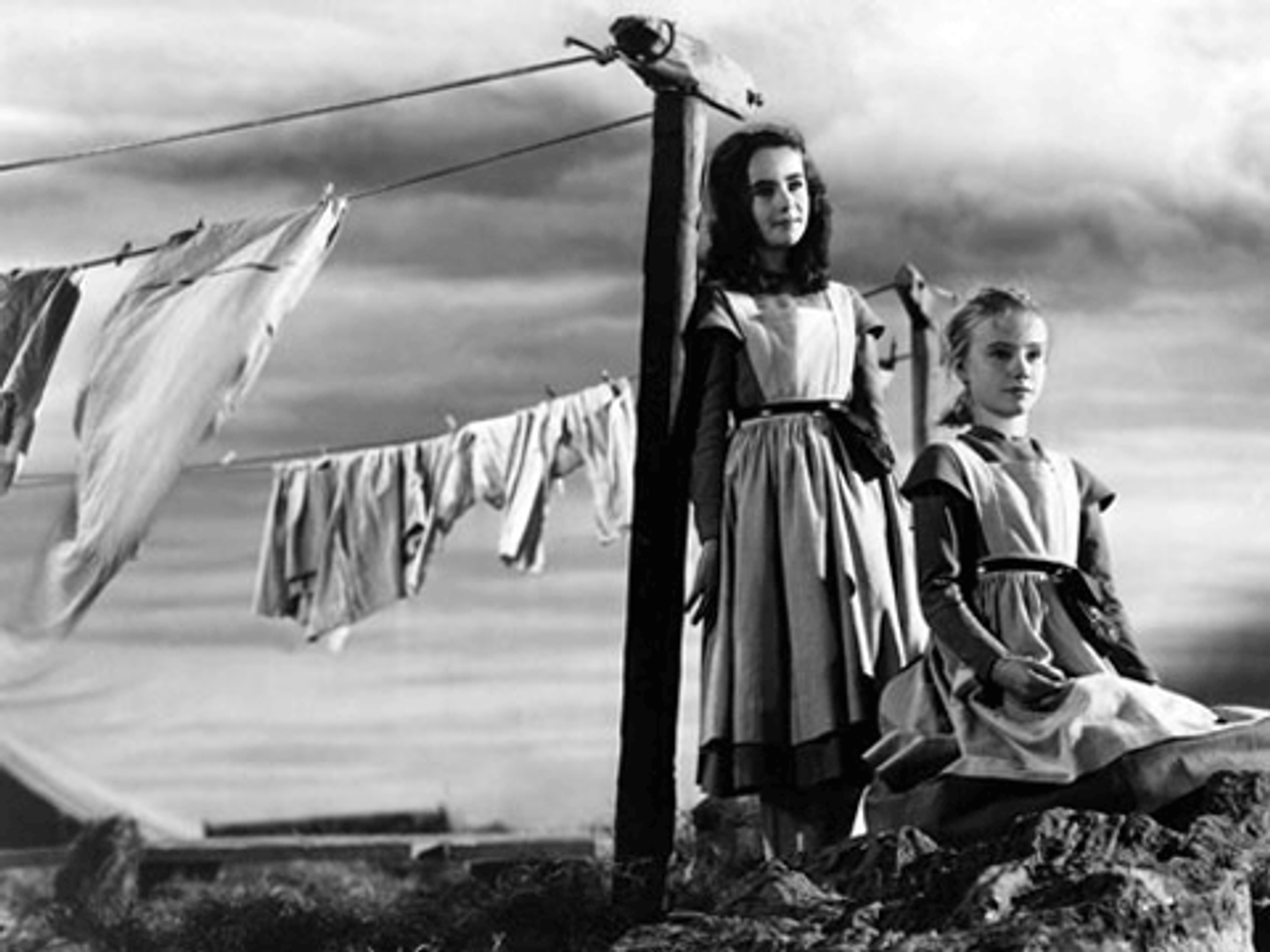 Jane Eyre
Jane EyreTaylor featured in a more significant film, Robert Stevenson’s Jane Eyre, with Joan Fontaine and, above all, Orson Welles as Rochester, released in 1944. She played Helen Burns, young Jane’s friend at Lowood Institution, a horrible charity school, who dies of consumption in part thanks to the brutality of the pious clergyman, Mr. Brocklehurst (Henry Daniell), who runs the school. The sequence remains very moving.
Taylor made an impression in National Velvet (Clarence Brown, 1944), Life With Father (1947)—Michael Curtiz’s evocation of New York City in the 1880s, with William Powell and Irene Dunne—and Mervyn LeRoy’s version of Louisa May Alcott’s Little Women (1949). She also appeared memorably in Father of the Bride (1950) and its sequel, Father’s Little Dividend (1951), both directed by Vincente Minnelli and co-starring Spencer Tracy and Joan Bennett. All of this before she was 20 years old.
In an interview conducted much later in life, Taylor noted that she had never taken a single acting lesson and that her teachers were her fellow actors and directors, the “people on the set.” She asserted that her acting was “purely instinctive.” Although the latter comment is, of course, an exaggeration, insofar as it contains a certain degree of truth it hints at what are almost inevitably the strengths and weaknesses of the self-taught actor. Not someone who could propel a film in an important direction by her own consciously focused thought or feeling, Taylor was highly dependent on a gifted director and gifted fellow performers.
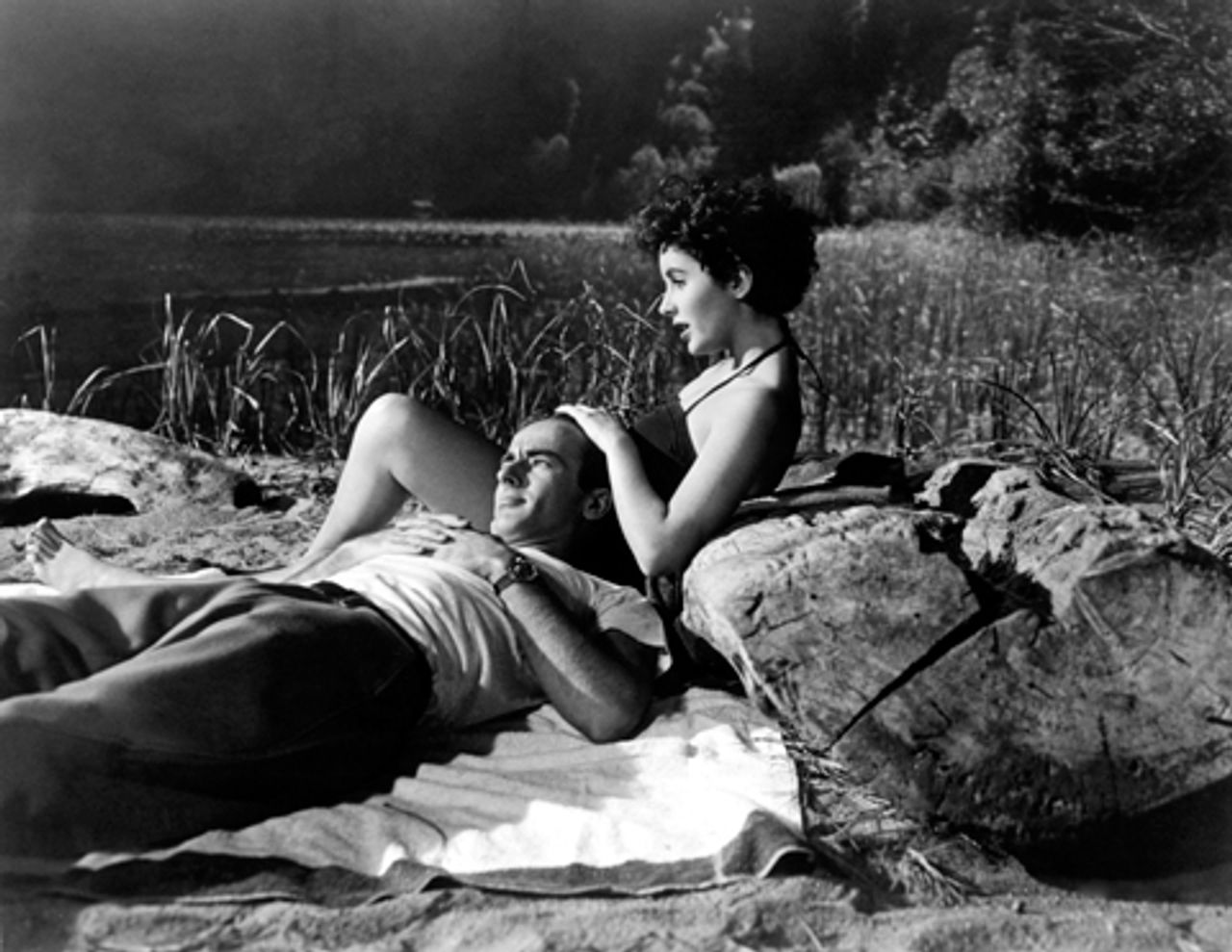 A Place in the Sun
A Place in the SunIn the same conversation, Taylor stated that she only “started to take acting seriously” during the production of A Place in the Sun (1951), working with actor Montgomery Clift, who was to become another lifelong friend, and director George Stevens. Again, this is an exaggeration, as a viewing of the above-mentioned films demonstrates. Taylor asserted half-jokingly that previous to A Place in the Sun, she had only acted with “dogs and horses” (the Lassie films and National Velvet). In fact, she had already worked with a number of talented Hollywood veterans in Brown, Curtiz and LeRoy, if the projects in question were not very substantial.
A Place in the Sun was actually shot in late 1949, when Taylor was only 17. Father of the Bride and Father’s Little Dividend, it seems, were filmed after the Stevens’ production, although both were released earlier. On the basis of viewing the respective films, this makes a good deal more sense than the reverse order, because Taylor has obviously “started to take acting seriously” by the time of the Minnelli films.
Even in such a slight film as Father’s Little Dividend, Taylor has a number of scenes with Tracy that are sensitive, well-paced and intelligent. Minnelli was a remarkable director, even in this ostensible paean to middle-class postwar life. One of the striking features about the Tracy-Taylor sequences is how much time the director takes to work the dialogue through and how harmoniously the actors work together. Taylor, who was 18 or so when the shooting occurred, is both modest and also remarkably mature for her years.
In any event, A Place in the Sun was without question a turning point in her career. Apparently, Stevens had wanted to film a version of Theodore Dreiser’s 1925 masterpiece An American Tragedy for years. The novel treats a poor relation of a wealthy family who impregnates a factory girl and then finds her an encumbrance when he enters into a relationship with a rich, pretty girl, a relationship that promises to open up for him a golden world of comfort and affluence. Dreiser’s work is a devastating indictment of the American striving for success at any cost, painstakingly and painfully built up, inexorable incident by inexorable incident.
George Stevens, the son of actors, started out in the film industry as a cameraman, working on numerous Laurel and Hardy short films, and began directing in the mid-1930s (Alice Adams, Swing Time, Gunga Din). During World War II, he headed a film unit that shot footage of the D-Day invasion, the liberation of Paris, the meeting of US and Soviet troops at the Elbe River, and Nazi atrocities at the Dachau concentration camp.
Stevens’ special army unit included left-wing and future blacklisted writer Irwin Shaw, along with Ivan Moffat, the British-born grandson of legendary actor-manager Sir Herbert Beerbohm Tree and a onetime Communist Party member as well.
A Place in the Sun was viewed as a left-wing project by many of its participants. In addition to the presence of Moffat, who served as associate producer, another future blacklist victim, Michael Wilson, co-wrote the screenplay. Actors Shelley Winters and Anne Revere, the latter appearing in her last film until 1970 because of the anti-communist witch-hunts, were known for their leftist views and connections.
Stevens’ film does not possess the frightening power of Dreiser’s novel, but a product of the studio system at the time would not have been likely to. In the name of “modernizing” the drama (the events on which the book was based took place in 1906 and the novel, as noted, was published in 1925), the screenwriters of A Place in the Sun—the title was suggested by Moffat—placed the elements of romance and sexual attraction much more at the forefront.
Dreiser’s protagonist is driven in a complicated manner by the combination of the rich girl’s personal charms and the desirability of a bright, fun-filled, prosperous life among people who ‘count for something’ in society. The girl is charming, above all, because she represents and embodies that existence. To a certain extent, in fact, Dreiser’s hero endows her with all manner of qualities because he so fiercely wishes to have a different life.
Not so in the Stevens’ work. Taylor is intended to be genuinely alluring in her own right, and one might draw the conclusion that the Clift character makes his fatal choices based solely on the depth of his feelings for her.
In this regard, probably without being conscious of it, the writers and director of A Place in the Sun were already making concessions to the retrograde ideological climate in postwar America. In movies, economics would largely disappear as a significant factor in the consideration of psychic life, to the serious detriment of the works produced. Taylor, unwittingly, became one of the vehicles for that change.
Nonetheless, to the degree that important strengths of the Dreiser original were retained and that the contributions of Stevens and the others involved were serious ones, A Place in the Sun remains in many ways a strong and critical work.
After this auspicious beginning as an adult in films, Taylor was relegated to mostly minor movies over the next several years, with the colorful exception perhaps of Ivanhoe (1952, Richard Thorpe). Richard Brooks’ Last Time I Saw Paris (1954) is also worth noting, although it is not an especially successful film. Still, its ultimate source, an F. Scott Fitzgerald story, and the suggestion of postwar emotional dysfunction are enough to set off certain useful reverberations. Taylor is very striking in the film, again mature beyond her biological age of 21 or so. (It is amusing to see her in scenes with Roger Moore, who seems far younger than she, although he was actually five years older!)
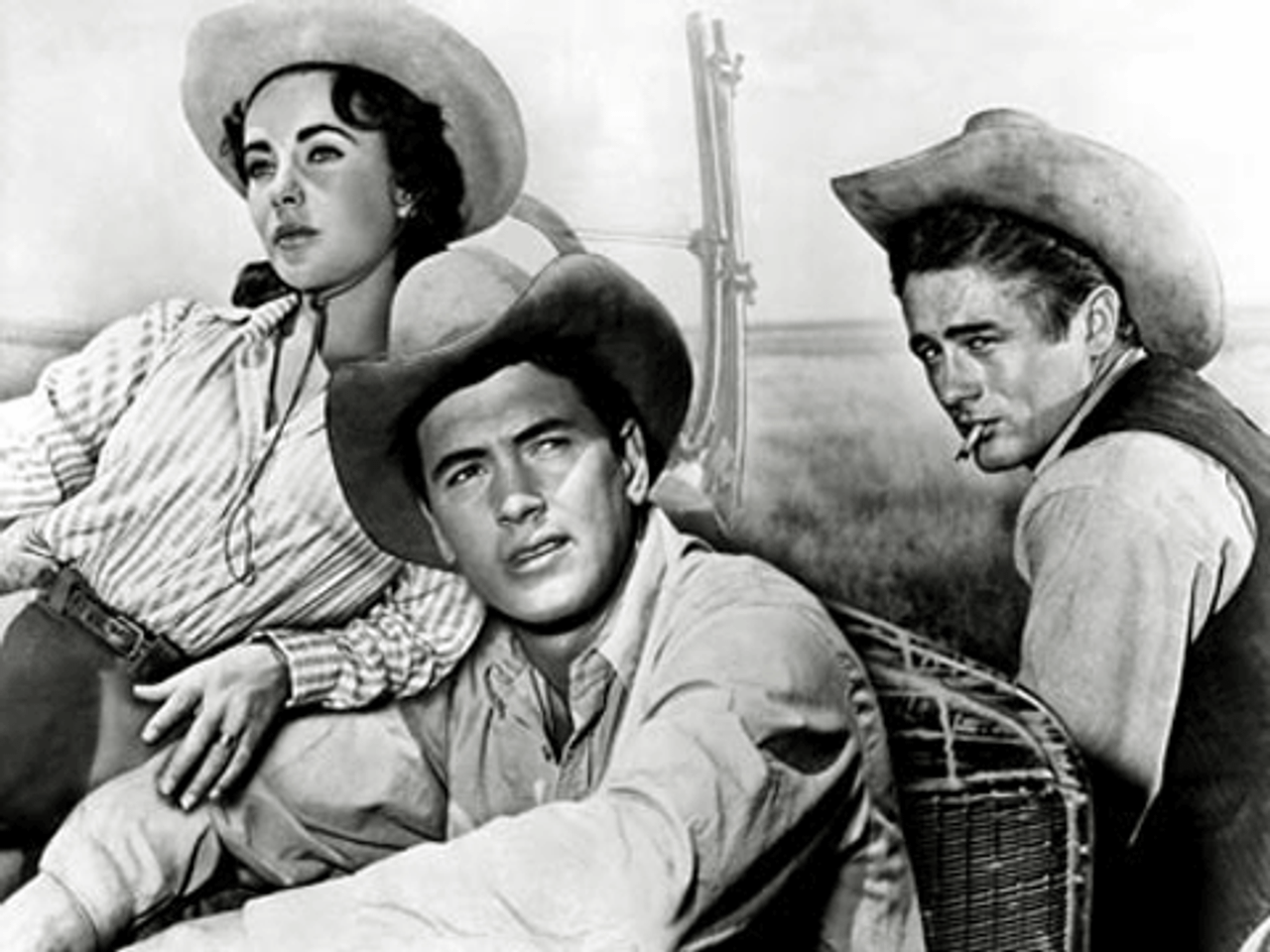 Giant
GiantTaylor had a major role in another George Stevens’ production, Giant, released in 1956. The story of a Texas ranching family across several generations, the film raised questions about the 19th century theft of territory from Mexico, as well as the modern-day treatment of Mexicans in the US. Giant’s picture of the oil boom and resulting petroleum industry in particular are unflattering. Somewhat stiff and labored, not as intimate or intense as A Place in the Sun (but then Edna Ferber had taken the place of Theodore Dreiser!), the 3-hour film still stands up as a relatively biting view of modern American life and its roots.
Taylor next worked with former Hollywood Ten victim, and subsequent informer, director Edward Dmytryk on Raintree County, a forgettable film set in the Civil War era. Co-star Montgomery Clift suffered a serious and disfiguring auto accident during the shooting in May 1956 (Taylor arrived at the scene of the crash and reportedly prevented his choking), an event that led him to rely increasingly on alcohol and pills, which, in turn, helped bring about his early death in 1966.
The (enforced) decline in the level of historical and social insight in Hollywood films in the 1950s, ultimately the product of the anti-communist purges and the virtual criminalization of left-wing thought in the entertainment industry, was accompanied by an increase in the level of emotional and technological bombast. It seems reasonable to suggest that a relationship exists between many Hollywood movies becoming “larger than life,” on the one hand, and the filmmakers’ difficulties, on the other, in facing up to the actual circumstances of existence.
Under conditions where treating certain elementary socio-economic facts of life is taboo in art, but the intensity and contradictions of life have not gone away, the emotionally melodramatic element may be a consequence. In the hands of a Douglas Sirk (All That Heaven Allows, Written on the Wind, Imitation of Life), the left-wing German émigré, lush melodrama in the 1950s reached considerable artistic and socially critical heights.
The films that Taylor worked in never attained the degree of precise insight present in Sirk’s work, but taken as a whole they represent an enduring and memorable comment on the complexities and dilemmas of American life.
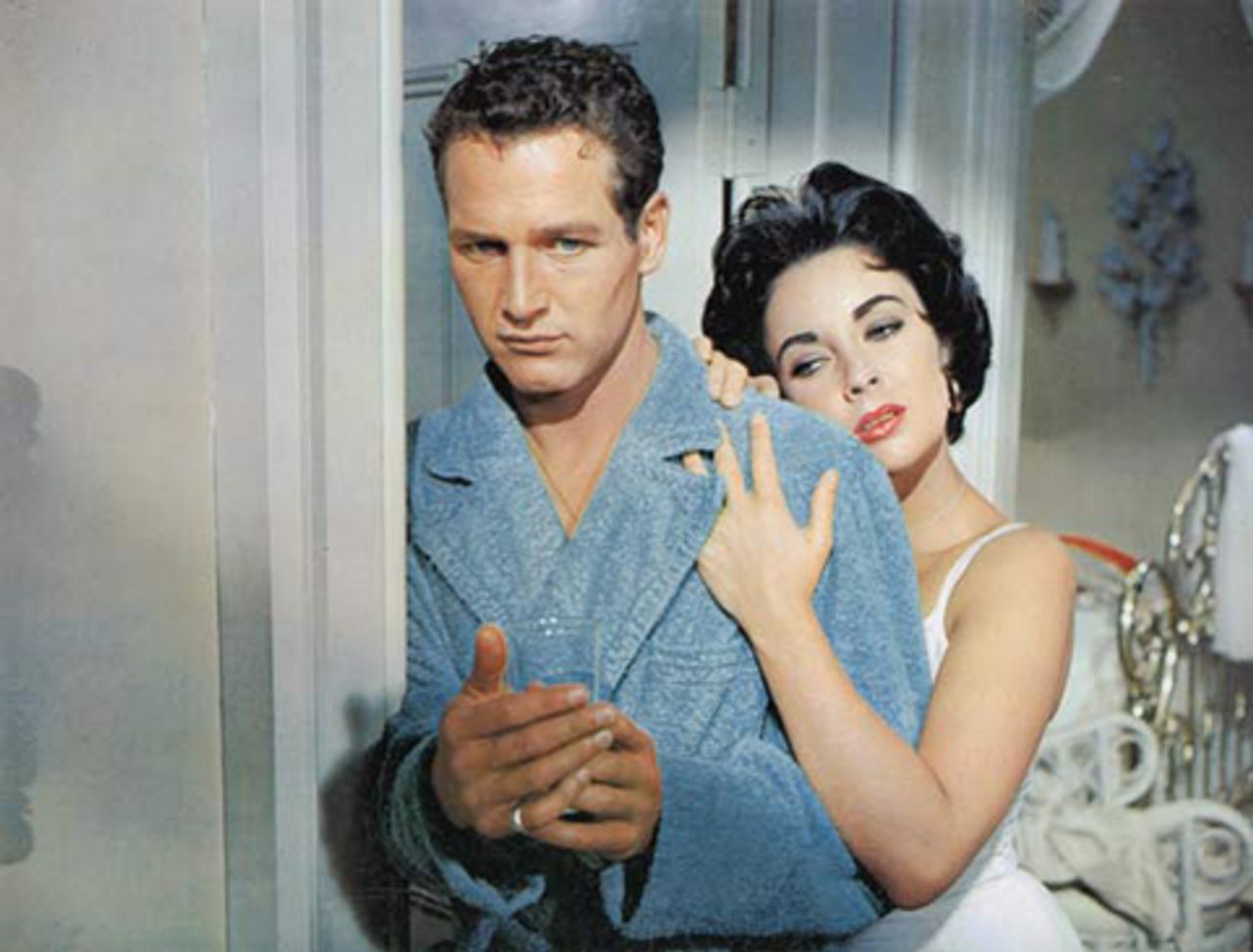 Cat on a Hot Tin Roof
Cat on a Hot Tin RoofRichard Brooks’ version of Cat on a Hot Tin Roof, despite its occasional foolish and over-the-top qualities (or because of them?), stands at the center of these efforts. Based on the Tennessee Williams play, the movie focuses on Brick (Paul Newman) and Maggie Pollitt (Taylor), a young married couple visiting his wealthy father’s “plantation” in Mississippi. A former star athlete, Brick is retreating into alcohol and rejects his wife’s sexual advances. He blames her for the suicide of his best friend.
Meanwhile, Brick’s father, “Big Daddy” (Burl Ives), is dying of cancer, and the various family members, including Brick’s brother Gooper (Jack Carson) and his awful, opportunist wife, are positioning themselves to divide up the wealth.
Taylor is delightfully brash and vulgar as Maggie (the “cat” in question), and the performers in general chew up the scenery, but the film wants to say something about American life and the South in particular, at a time when the civil rights movement had broken out in the form of the Montgomery, Alabama bus boycott (1955) and the Little Rock, Arkansas integration crisis (1957).
Wildly, angrily, Cat on a Hot Tin Roof takes on social backwardness, corruption, racism (at least by implication) in a relatively compelling fashion. “Big Daddy” gets to decry the “odor of mendacity” that pervades his sprawling home and Maggie denounces Gooper and his wife for their “avarice and greed.” Brick complains that his father has merely “bought a million dollars worth of things” instead of showing any genuine human emotion.
The film, in my opinion, is considerably more interesting and forceful than Elia Kazan’s A Streetcar Named Desire (1951), also based on a Williams play, which stays closer to the original and wallows in self-pity. Tragically, during the filming of Cat on a Hot Tin Roof, in March 1958, Taylor’s third husband Mike Todd, a film and theater producer, died in an airplane crash.
BUtterfield 8 (Daniel Mann, 1960), based on a John O’Hara novella, is a flawed and moralizing work, but, again, Taylor’s vivacity as a Manhattan call girl, who finds love and comes to a tragic end, stands out. Laurence Harvey plays a wealthy businessman and Yale graduate who first tries to buy Taylor’s affections. A friend tells him, “You’re a heel… a low-down rotten heel… Anything that doesn’t go your way, anything that you can’t have, you destroy.” The portrait of affluent New York and its victims is a relatively grim one.
Joseph Mankiewicz’s Cleopatra (1963) gained enduring fame primarily for its spectacular cost ($300 million in contemporary dollars) and its part in the launching of the Taylor-Richard Burton romance. Like many of the epics of the time, Cleopatra (at over four hours, in its restored version) tends toward the turgid and overblown.
Nevertheless, the drama of the famed queen’s relations with Romans Julius Caesar (Rex Harrison) and Mark Antony (the dynamic Burton), as she struggles to advance her own claims on the Egyptian throne in the 1st century BC, still holds a certain fascination.
The presence of innumerable talented character actors, including Martin Landau, Hume Cronyn, Kenneth Haigh, McDowall and others, enhances the work, as do the extraordinary set design and overall artistic conception. The entrance of Taylor as Cleopatra into Rome seated on a three-story high black stone sphinx pulled by 300 slaves was no small feat. And Hollywood films of the time, in their own peculiar fashion, tried to stay somewhat true to the events, or the perceived truth of the events. The filmmakers possessed a stronger historical sensibility than their contemporary counterparts.
Unfortunately for them, Taylor and Burton became one of the first modern “celebrity” couples. Married and divorced twice, their own personal saga, endlessly covered by a media in the process of discovering new means of misinformation, lasted virtually until Burton’s death in August 1984 at the age of 58.
By all accounts, including a collection of letters from Burton to Taylor brought to light in 2010 for a biography of the pair, they genuinely loved each other. Taylor told the biographers: “He was the kindest, funniest and most gentle father. All my kids worshiped him. Attentive, loving—that was Richard. The bond with all of us continued until he drew his last breath. In my heart, I will always believe we would have been married a third and final time... from those first moments in Rome we were always madly and powerfully in love.”
Their talent and notoriety earned Taylor and Burton a great deal of money in the 1960s ($88 million, or more than $600 million in today’s money), but it earned the film studios far more. According to one source, although the time period is not clear, “nearly half of the US film industry's income... came from pictures starring one or both of them.”
Their celebrity status and the immense pressures generated by their financial significance to the industry no doubt took their toll. Burton, a Welsh miner’s son, must have felt a deep ambivalence about his wealth and success; the unspoken accusation (perhaps self-accusation) was that here was a classically trained actor who had abandoned serious work on the stage or in art cinema for the fleshpots of Hollywood.
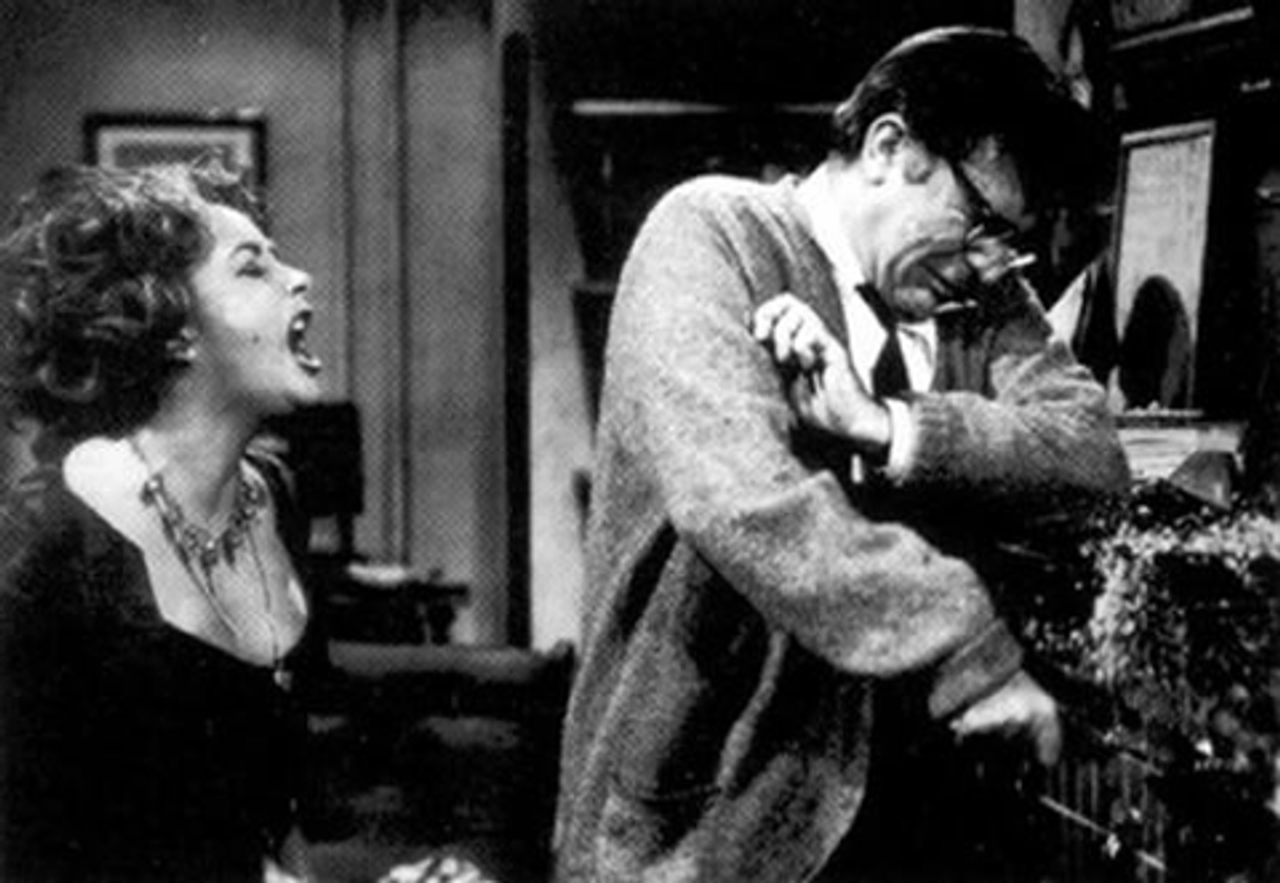 Who’s Afraid of Virginia Woolf?
Who’s Afraid of Virginia Woolf?The couple appeared in seven films together in the 1960s, including The V.I.P.s (1963), The Sandpiper (1965), Shakespeare’s The Taming of the Shrew (1967), Christopher Marlowe’s Doctor Faustus (1967), The Comedians (1967)—based on a Graham Greene novel about Haiti during the Duvalier regime—and Boom! (1968). The most memorable, however, is Who's Afraid of Virginia Woolf? (1966), directed by Mike Nichols and based on the Edward Albee play.
The well-known work, first staged in 1962 on Broadway, takes place during one late Saturday night-early Sunday morning in the lives of associate history professor George (Burton) and his wife Martha (Taylor), the daughter of the small New England college’s president. The pair is entertaining, beginning at 2 am, another couple, Nick (George Segal) and Honey (Sandy Dennis).
Martha drinks too much and enjoys humiliating George, either when alone or in front of others, about his various career and purported physical inadequacies. George fantasizes about murdering Martha, pointing a shotgun at her at one point that turns out to release an umbrella. She flirts with Nick, and George dances with Honey. Things go from bad to worse at a roadhouse, where the drinking and taunting continue.
The subject of George and Martha’s son comes up again and again over the course of the night. Only toward the end does Nick, and the spectator, realize that the pair never had a child for unexplained reasons, but play a ritualistic and venomous game about the imaginary offspring.
There are numerous irritating and implausible elements about the film, including the unconvincing business about the child, and Nichols does too much to underline the psychological and sociological importance of the goings-on. The “third act of Virginia Woolf,” wrote critic Andrew Sarris at the time, (“a brilliant play about Living and a bad play about Life”), “degenerates into hysterical charades,” in a comment not without some truth to it.
But there is still something to the play and the film, in its anger at the hypocrisy, falseness and shallowness of conventional, respectable life in the US. Albee’s play suggests, in fact, that a good deal of officially presented America is rooted in lies and illusions, lies and illusions about one’s own life and about other people, lies and illusions that need to be peeled away if anything is to be salvaged. (The names George and Martha can be interpreted as a reference to George and Martha Washington, America’s “founding father and mother;” the former of course, according to legend, “could not tell a lie.”)
Burton’s performance is remarkable. Sarris noted that Taylor lacked “Burton’s heroic calm, particularly in the all-too-rare quiet moments when she is supposed to be listening and reacting, moments that are the supreme tests of acting.” Taylor, however, would have been the first to grant that Burton was the superior performer, but her sincerity and presence count for a good deal.
In little more than fifteen years, after all, Taylor had gone from Hollywood starlet, appearing in such lightweight pieces as Love Is Better Than Ever and The Girl Who Had Everything, to the attempt, at least, to offer a jarring, lacerating performance in Who’s Afraid of Virginia Woolf? Changes in the world and in America had a good deal to do with that, but still…
In 1951, by contrast, Burton was performing at Stratford as Prince Hal in “a critically acclaimed performance” of Shakespeare’s Henry IV, Part I, opposite Anthony Quayle as Falstaff. He became a member of the fraternity of great British actors of the day, including John Gielgud, Michael Redgrave, Paul Scofield, Alec Guinness, Quayle and others. Who had traveled the greater artistic and intellectual distance in that decade and a half, Burton or Taylor?
At the time of Who’s Afraid of Virginia Woolf’s release in June 1966, Elizabeth Taylor, astonishingly, was only 34 years old. This was her last major film. She went on to make two movies with director Joseph Losey (Boom! and Secret Ceremony, both released in 1968), already having entered into the least interesting phase of his career, and one more, rather tired film with George Stevens (The Only Game in Town, 1970), but there is not much more after that. The primary fault lies with the Hollywood studios, which were artistically falling apart and eventually would come under the control of giant conglomerates.
Taylor devoted much of her life to causes and people to whom she felt close. Unless the reports are false, her attachment to individuals such as Clift, Rock Hudson, Michael Jackson and others she perceived to be “outsiders,” and hence vulnerable, seems quite genuine. She became a champion of HIV and AIDS-related projects as early as 1984, at a time when the disease was hardly acknowledged. Hudson’s death in 1985 deepened her commitment. Even her conversion to Judaism in 1959, which also led her to misguided and uncritical support for the Israeli state, probably derived at least in part from her perception of the Jews as victims of oppression.
One might consider Elizabeth Taylor’s body of work in the 1950s and 1960s as a single, long-running melodrama about American life (of which her own participation in “real life” in various romantic scandals formed a subplot). No single work stands out as brilliantly insightful or entirely successful, but watching the various movies gives one a picture—granted, a one-sided and distorted, overly “psychological,” picture (i.e., it is missing the real driving forces in economic and social life)—of a society.
The inhabitants of this social universe are lively and not afraid to express themselves, or reticent to complain, but they are beset by corruption, greed, anxiety, conformism, racism, phony piety, status seeking, unsatisfying and corrosive personal relations. And they respond, in the only fashion apparently open to—or permitted—them, with extravagant and disordered personal behavior for the most part: alcoholism, various addictions, sexual promiscuity, escape into fantasy, violence, even madness. If the portrait is not a happy or entirely coherent one, the fault doesn’t lie with the films or filmmakers, or leading performers such as Elizabeth Taylor, but with the social order itself.
